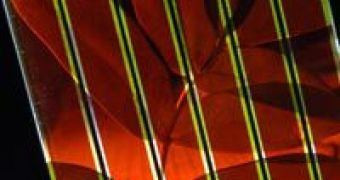Dye Solar Cells (DSC) technology has been described as 'artificial photosynthesis' using an electrolyte, a layer of titanium (a pigment used in white paints and tooth paste) and ruthenium dye sandwiched between glass. Light striking the dye excites electrons which are absorbed by the titanium to become an electric current many times stronger than that found in natural photosynthesis in plants.
Compared to conventional silicon based photovoltaic technology, DSC technology has lower cost and embodied energy in manufacture, it produces electricity more efficiently even in low light conditions and can be directly incorporated into buildings by replacing conventional glass panels rather than taking up roof or extra land area.
Australian solar power company Dyesol has now successfully demonstrated their solar panel which is based on a flexible metal substrate. The rugged lightweight panels have been developed under a two year contract with the Australian Defence Science and Technology Organization.
Less than four months after signing a $2 million, 2 year contract to demonstrate flexible solar panels based on Dye Solar Cell technology to provide portable and sustainable energy, the project team has met the first major contract milestone.
Flexible solar panels hold promise for applications including powering cooling, communications, and sensors, either as light weight mobile power-packs, or integrated into field structures.
"Many competitors are focusing on plastic solar panels, but we believe that metallic substrates will provide solar panels that are much more suitable for rugged, lightweight portable power," said project Director, Dr. Gavin Tulloch.

 14 DAY TRIAL //
14 DAY TRIAL //